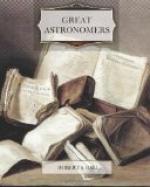Before Tycho was seventeen he had commenced the difficult task of calculating the movements of the planets and the places which they occupied on the sky from time to time. He was not a little surprised to find that the actual positions of the planets differed very widely from those which were assigned to them by calculations from the best existing works of astronomers. With the insight of genius he saw that the only true method of investigating the movements of the heavenly bodies would be to carry on a protracted series of measurements of their places. This, which now seems to us so obvious, was then entirely new doctrine. Tycho at once commenced regular observations in such fashion as he could. His first instrument was, indeed, a very primitive one, consisting of a simple pair of compasses, which he used in this way. He placed his eye at the hinge, and then opened the legs of the compass so that one leg pointed to one star and the other leg to the other star. The compass was then brought down to a divided circle, by which means the number of degrees in the apparent angular distance of the two stars was determined.
His next advance in instrumental equipment was to provide himself with the contrivance known as the “cross-staff,” which he used to observe the stars whenever opportunity offered. It must, of course, be remembered that in those days there were no telescopes. In the absence of optical aid, such as lenses afford the modern observers, astronomers had to rely on mechanical appliances alone to measure the places of the stars. Of such appliances, perhaps the most ingenious was one known before Tycho’s time, which we have represented in the adjoining figure.
[Plate: Tycho’s cross staff.]
Let us suppose that it be desired to measure the angle between two stars, then if the angle be not too large it can be determined in the following manner. Let the rod ab be divided into inches and parts of an inch, and let another rod, CD, slide up and down along ab in such a way that the two always remain perpendicular to each other. “Sights,” like those on a rifle, are placed at A and C, and there is a pin at D. It will easily be seen that, by sliding the movable bar along the fixed one, it must always be possible when the stars are not too far apart to bring the sights into such positions that one star can be seen along DC and the other along DA. This having been accomplished, the length from A to the cross-bar is read off on the scale, and then, by means of a table previously prepared, the value of the required angular distance is obtained. If the angle between the two stars were greater than it would be possible to measure in the way already described, then there was a provision by which the pin at D might be moved along CD into some other position, so as to bring the angular distance of the stars within the range of the instrument.
[Plate: Tycho’s “New star” Sextant of 1572. (The arms, of walnut wood, are about 5 1/2 ft. long.)]




